Pressure is building from within the financial services industry as the House of Representatives Standing Committee on Economics scrutinise APRA over its restrictions on investor and interest-only lending.
Appearing before the committee on Wednesday (28 March), the Australian Prudential Regulation Authority (APRA) faced intense scrutiny over its macro-prudential measures, which placed a 10 per cent on investor loans and 30 per cent cap on new interest-only loans.
Committee member and Labor MP, Matthew Thistlethwaite, questioned APRA chairman Wayne Byres over the effect that the measures have had on interest rates, and therefore on the cost of living. Mr Thistlethwaite alleged that lenders increased interest rates on all loans as a result of the introduction of the interest-only (IO) cap, which he said “pushed up the cost of living for Australian households”.
Speaking at The Adviser’s Better Business Summit earlier this month, NAB chief economist Alan Oster claimed that regulatory restrictions on interest-only (IO) loans were overblown.
“I think everyone sort of sells the argument about [interest-only loans], as if it’s a regulatory thing, that they’re more risky — that’s not true in Australia. That is factually not true, but people are saying that it’s a bubble,” Mr Oster said.
The chief economist said he believes that while regulators increasingly favour the use of macro-prudential tools, a distinction should be made between perceived lending risks and over-stimulation in the market.
“There’s a confusion between a regulatory thing that says this is more risky and therefore I should do ‘x’ and something else that says, ‘I want to take some heat out of the market’, which is [traditionally] what interest rates did. But now that [regulators are] using [macro-prudential measures], they’ll probably sit on interest rates.”
“The 10 per cent investor growth benchmark that we put in place in December 2014, I think that is becoming redundant.”
APRA admits restrictions are becoming redundant
When asked when APRA would lift the caps, Mr Byres stated that the caps were temporary measures designed to “dampen some of the excess competitive spirit”, stating that the investor benchmark is “becoming redundant”.
“They are intended to be a temporary measure just to dampen some of the excess competitive spirit that was producing lower quality lending and higher risk lending.
“I said in this room a month or so ago, the 10 per cent investor growth benchmark that we put in place in December 2014, I think that is becoming redundant,” he continued.
“Who knows how things evolve, but I think we're in a position where that can be removed sooner rather than later.”
The APRA chairman, however, suggested that the regulator has no immediate plans to remove its IO benchmark.
“The 30 per cent interest-only benchmark is one that we've only just got in place. The industry and the market is still settling,” he said.
How did the banks restrict investor and interest-only lending?
Once APRA enforced the restrictions in 2014 on investor lending to 10% of each lender’s portfolio and a maximum of 30% on interest-only loans, the lenders had to make their products less ‘attractive’ to borrowers. One way was to increase the interest rate for products servicing these loans.
The other method was to push borrowers to a principal and interest (P&I) repayment structure, by changing the credit policies to make it more difficult for borrowers to meet requirements for interest-only loans. This change impacted both home loans and investment loans.
Those borrowers who had to continue their application with a lender who increased their rates and changed their payment structure, just had to absorb the costs, or face a declined application.
Time is up for investor and interest-only lending restrictions
Interest-only restrictions have a greater impact than expected
When home loans or investment loans suddenly increase due to interest rates or moving to a P&I loan repayment, something else has to give. Cost of living has increased both for the borrower, and for renters who had their rents increased to help cover the investors increased lending costs.
When cost of living goes up, consumer spending goes down. Retailers feel the pinch first as home owners save money to put towards the mortgage. Consumers go without to ensure the meet their mortgage requirements. In fact, mortgage default rates have improved and there is no clear sign that Australians are battling to meet their mortgage repayments. Only 1.54% of mortgages are classified as overdue 30 days, indicating mortgage debt takes priority.
“Data shows consumers are spending less on items such as personal goods, charitable donations, major household items, eating out and entertainment. Whereas spending has increased for utilities, medical expenses, transport and groceries.”
Household finances biggest concern
In the NAB Quarterly Consumer Behaviour Survey: Q4 2017, NAB Group Chief Economist Alan Oster said, “The cost of living is still weighing most heavily on them, highlighting the disconnect between low levels of economy-wide inflation and consumer focussed costs”.
The data shows consumers are spending less on items such as personal goods, charitable donations, major household items, eating out and entertainment. Whereas spending has increased for utilities, medical expenses, transport and groceries.
When consumers have to spend more on essential items, non-essential spending decreases and its usually small business who feel the pain. Consumers are already spending less money on eating out and entertainment than in 2016, so the decrease in spend is likely to continue throughout 2018.
investor and Interest-only options are becoming more accessible
Good news is, some lenders are still accepting interest-only loans for both investment and owner occupied. The options are very much cyclical, so as one lender stops interest-only lending, another opens their doors. The trick is to work with an experienced mortgage broker to find the most favourable option for your lending situation.


